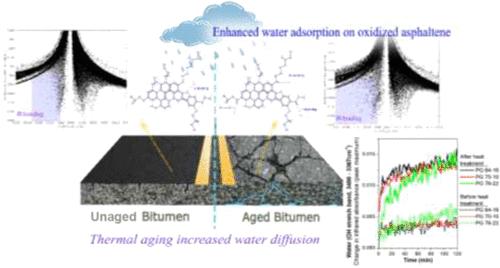Investigating the Diffusion Dynamics of Moisture in Thermally Aged Bitumen
IF 3.9
3区 工程技术
Q2 ENGINEERING, CHEMICAL
引用次数: 0
Abstract
Moisture susceptibility is a major contributor to asphalt pavement deterioration, leading to increased maintenance costs and reduced service life. Despite the known importance of moisture damage, the molecular mechanisms by which oxidative aging influences water diffusion in bitumen─the primary binder in asphalt─remain insufficiently understood. This study aims to bridge that knowledge gap by examining how thermal aging alters the moisture resistance of bitumen through changes in its molecular structure and interfacial behavior. We employed differential Fourier transform infrared (D-FTIR) spectroscopy to monitor real-time water diffusion in thin films of thermally aged and unaged bitumen. Additionally, we used density functional theory (DFT) calculations to quantify water–bitumen interactions and identify how aging-induced chemical modifications affect bitumen’s polarity. D-FTIR analysis revealed that thermal aging significantly increased water uptake across all bitumen grades tested, with aged samples showing faster and more sustained diffusion. The spectra also showed codiffusion of polar bitumen components─particularly resins and asphaltenes─toward the water-exposed surface, while nonpolar molecules migrated away. DFT results confirmed that these polar compounds exhibit higher interaction energies with water, and that oxidation introduces polar functional groups (e.g., carbonyl and sulfoxide) that enhance hydrogen bonding and electrostatic interactions with water molecules. Overall, this work demonstrates that oxidative aging promotes water adsorption and accelerates diffusion by increasing molecular polarity and inducing surface redistribution of bitumen components. These findings offer important insights for the development of more durable, moisture-resistant bitumen formulations, ultimately supporting longer-lasting and more sustainable asphalt pavements.

热老化沥青中水分扩散动力学研究
湿气易感性是沥青路面恶化的主要原因,导致维护成本增加,使用寿命缩短。尽管已知水分损害的重要性,但氧化老化影响沥青(沥青的主要粘结剂)中水分扩散的分子机制仍未得到充分了解。本研究旨在通过研究热老化如何通过改变沥青的分子结构和界面行为来改变沥青的抗湿性,从而弥合这一知识差距。采用微分傅里叶变换红外光谱(D-FTIR)实时监测了热老化和未老化沥青薄膜中水分的扩散。此外,我们使用密度泛函理论(DFT)计算来量化水-沥青的相互作用,并确定老化引起的化学修饰如何影响沥青的极性。D-FTIR分析显示,热老化显著增加了所有沥青等级的吸水率,老化样品的扩散速度更快,持续时间更长。光谱还显示极性沥青组分──特别是树脂和沥青烯──向暴露于水的表面共扩散,而非极性分子则向外迁移。DFT结果证实,这些极性化合物与水表现出更高的相互作用能,并且氧化引入极性官能团(例如羰基和亚砜),增强了氢键和与水分子的静电相互作用。总的来说,这项工作表明,氧化老化通过增加分子极性和诱导沥青组分的表面再分配来促进水的吸附和加速扩散。这些发现为开发更耐用、更防潮的沥青配方提供了重要的见解,最终支持更持久、更可持续的沥青路面。
本文章由计算机程序翻译,如有差异,请以英文原文为准。
求助全文
约1分钟内获得全文
求助全文
来源期刊

Industrial & Engineering Chemistry Research
工程技术-工程:化工
CiteScore
7.40
自引率
7.10%
发文量
1467
审稿时长
2.8 months
期刊介绍:
ndustrial & Engineering Chemistry, with variations in title and format, has been published since 1909 by the American Chemical Society. Industrial & Engineering Chemistry Research is a weekly publication that reports industrial and academic research in the broad fields of applied chemistry and chemical engineering with special focus on fundamentals, processes, and products.
 求助内容:
求助内容: 应助结果提醒方式:
应助结果提醒方式:


